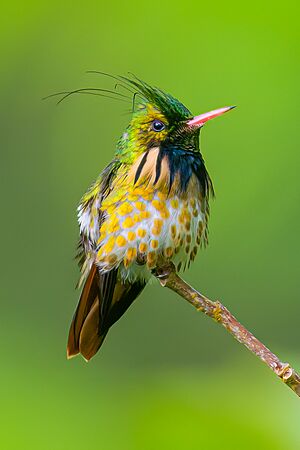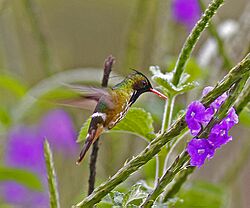Black-crested coquette facts for kids
Quick facts for kids Black-crested coquette |
|
|---|---|
 |
|
| Conservation status | |
| Scientific classification | |
| Genus: |
Lophornis
|
| Species: |
helenae
|
| Synonyms | |
|
Ornismya helenae |
|
The black-crested coquette is a tiny, colorful hummingbird. It's known for its special crest, especially the male's. You can find this bird in parts of Central America, including Mexico, Belize, Guatemala, Honduras, Nicaragua, and Costa Rica.
Contents
About the Black-crested Coquette
What is a Coquette?
The black-crested coquette is a type of hummingbird. It belongs to a group of hummingbirds called "coquettes." These birds are often very small and have fancy feathers. They get their name because of their showy looks.
How it Got its Name
Scientists first described this bird a long time ago. Its scientific name is Lophornis helenae. It was named by a scientist named Adolphe Delattre in 1843. The name helenae likely honors someone important to him.
What Does the Black-crested Coquette Look Like?
This hummingbird is quite small. It is about 6 to 8 centimeters (2.5 to 3 inches) long. It weighs only about 2.6 to 2.8 grams. That's less than a penny!
Male Coquette's Appearance
Male black-crested coquettes are very striking.
- They have a shiny, dark green crown on their head.
- A wispy, greenish-black crest sticks up from their head.
- Their back is a metallic bronze-green color.
- A white band separates their back from their dark rump.
- Their tail feathers are a mix of reddish-brown and dark tips.
- The chin and upper throat are bright metallic green.
- Below that, there's a velvety black band.
- The sides of their throat have cool tufts of buff-colored feathers. These tufts have black edges.
- Their chest is metallic bronze.
- Their belly is white with bronze spots.
- The bill is bright red with a black tip.
Female Coquette's Appearance
Female black-crested coquettes are also pretty, but less flashy.
- Their upper parts are dark metallic green or bronze-green.
- They have a narrow white band across their rump, just like the males.
- They do not have the male's crest.
- Their tail feathers are olive-bronze with blackish ends. The outer feathers are reddish-brown with a wide black band.
- Their face is black.
- Their chin and throat can be pale gray or cinnamon colored. They do not have the male's feathery tufts.
- Their chest is metallic bronze.
- Their belly is white with bronze spots.
- Their bill is black on top and red with a dark tip on the bottom.
Young Coquettes
Young males look a bit like adult females. However, they start to grow a small crest. Young females look very much like the adult females.
Where Do Black-crested Coquettes Live?
You can find the black-crested coquette in several countries. These include southern Mexico, eastern Guatemala, Belize, Honduras, Nicaragua, and eastern Costa Rica. There's also a separate group on the Pacific side of Central America.
They like to live in places with a mix of open areas and forests. This includes the edges of humid mountain forests and lowland evergreen forests. They also live in forest gaps and brushy areas. They can be found from sea level up to about 1,500 meters (4,900 feet) high.
How Do Black-crested Coquettes Behave?
Moving Around
Most black-crested coquettes stay in the same area all year. However, some in Costa Rica might move to different elevations depending on the season.
What Do They Eat?
These hummingbirds mainly eat nectar from flowers. They often look for nectar high up in the trees. They are known to "trap-line." This means they visit a regular circuit of flowering trees. They hover in front of flowers to drink the nectar. They also eat small arthropods, like tiny insects or spiders. They catch these bugs while flying or pick them off leaves.
Breeding and Nests
Not much is known about how black-crested coquettes raise their young. One nest was found in Costa Rica in March. It was a small, cup-shaped nest. It was built at the end of a twig, about 8 meters (26 feet) above the ground. This nest was at the edge of a forest.
What Sounds Do They Make?
Black-crested coquettes are usually very quiet birds. Sometimes, they make a clear, upward-sloping sound like "tsuwee." They might repeat this sound. When they are fighting, they can make a thin, high twittering noise. When they are feeding, they sometimes make a quiet, metallic "teek" sound.
Is the Black-crested Coquette in Danger?
The IUCN (International Union for Conservation of Nature) has looked at the black-crested coquette. They have assessed it as "Least Concern." This means it is not currently considered to be in danger of extinction. We don't know exactly how many there are or if their numbers are changing. However, they could be affected if their forest homes are destroyed.




